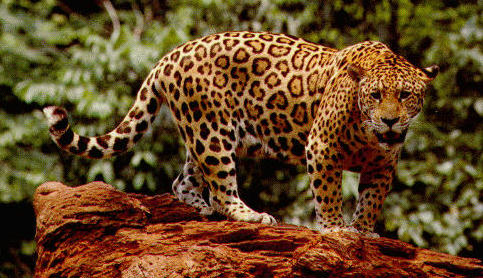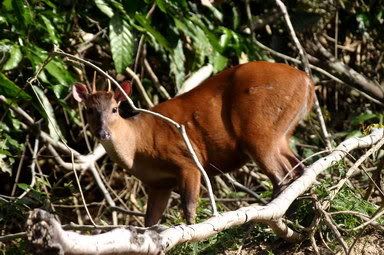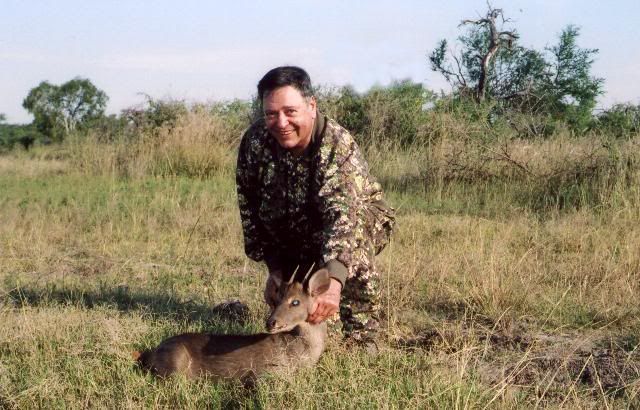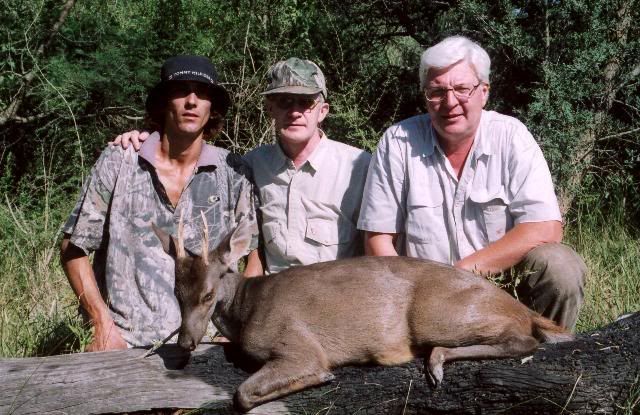

 The Accurate Reloading Forums
The Accurate Reloading Forums  THE ACCURATE RELOADING.COM FORUMS
THE ACCURATE RELOADING.COM FORUMS  Hunting
Hunting  South American Big Game Hunting
South American Big Game Hunting  What kind of deer did I see????
What kind of deer did I see????Go  | New  | Find  | Notify  | Tools  | Reply  |  |
| One of Us |
Last week, while dove hunting near Cordoba, Argentina I saw a deer that I can not identify. It was dark brown, weighed about 75lbs and had antlers (spikes) about 9" long. Thanks | ||
|
| One of Us |
Perhaps a huemul?  Steve "He wins the most, who honour saves. Success is not the test." Ryan "Those who vote decide nothing. Those who count the vote decide everything." Stalin Tanzania 06 Argentina08 Argentina Australia06 Argentina 07 Namibia Arnhemland10 Belize2011 Moz04 Moz 09 | |||
|
| One of Us |
I want one..... "When you play, play hard; when you work, don't play at all." Theodore Roosevelt | |||
|
| One of Us |
There are huemel (taruca) in Argentina, but they're in the Andes above 13,000 feet. The other indigenous deer in that country are the brocket (gray brown and lesser) deer, marsh deer, and pampas deer. Red deer, fallow deer, axis deer and other "exotics" also have been introduced, but none would be that small with antlers. The odds are what you saw was a gray-bown brocket deer (Mazama gouazoubira). Nine-inch spikes would be more than three inches longer than those on the SCI record head. As a full-pledged, dyed-in-the-wool aficionado de los venados, I'd like to hunt one of the brockets sometime. There are more full species of them than any other deer in the Americas. Bill Quimby | |||
|
| one of us |
Huemules (Hippocamelus bisulcus)and tarucas (Hippocamelus antisensis) are two different species - thou they are closely related.... huemul (the few that remain) can be found in the Patagonia and tarucas are high in the andes, mainly north of Argentina ... Can you be more specific? In which part of Cordoba did you see it (but in fact it could be an "implanted" specimen)? Was it wild or in a farm? Shapes of their antlers? Based on your description and place where you saw that deer, I think you saw a mazama, known here as guazuncho or corzuela (brocket deer)  ------------------------------------------  Μολὼν λάβε Duc, sequere, aut de via decede. | |||
|
| One of Us |
You saw: My Mother in Law !!! "Every ignored reallity prepares its revenge!" | |||
|
| One of Us |
Afrikaander: Numerous "experts" writing in English give Hippocamelus antisensis the common names of “Peruvian huemel OR Taruca, †and H. bisculcus is called the “Chilean huemul.†These are said to be the only two distinct species of the genus Hippocamelus, for which "huemul" is given as its common name. I bow to your superior knowledge of animals that are familiar to you, however. The odds are excellent that the so-called “experts†never saw either species alive and on the hoof in the wild. Bill Quimby | |||
|
| One of Us |
One of the Brocket Deer  Steve "He wins the most, who honour saves. Success is not the test." Ryan "Those who vote decide nothing. Those who count the vote decide everything." Stalin Tanzania 06 Argentina08 Argentina Australia06 Argentina 07 Namibia Arnhemland10 Belize2011 Moz04 Moz 09 | |||
|
| One of Us |
I only got a quick look at the deer. It was very dark brown, with no white on its rear end.The photo of the Brocket Deer looks the most like the deer. The outfitter told me he has only seen about 10 deer in his 17yrs of operation.I was about 80km north of Cordoba. Thanks | |||
|
| one of us |
Bill Quimby, I think both of us are saying pretty much the same ... in fact some people call the tarucas as "northern huemules"... you know, we all tend to call game in a generic way (deer ! I didn't want to "sound" as if I was correcting your post (far from that, in fact I found it pretty accurate, actually your post denotes you are a quite knowledged "(...)full-pledged, dyed-in-the-wool aficionado de los venados" Guillermo, at least you have a mother in law that can be appreciated, at least from a cynegetic point of view Bwana1, there are several species of mazamas, and their color is one of the differences that mark and distinguish one species from another... to judge the proper species from its color we also have to consider the probable age of the deer you saw, shades and quantity of sunlight existing in the time and place of your sight and a couple of variables more.... but most surely it was a brocket deer (and let me tell you that brocket deers are in fact quite difficult to see !!) ------------------------------------------  Μολὼν λάβε Duc, sequere, aut de via decede. | |||
|
| one of us |
I posted sometime ago something titled "A beautiful Argentine trophy". Altough my original picture has been deleted, Bill uploaded another one showing a taruca. You may look at it. | |||
|
| One of Us |
"...there are several species of mazamas, and their color is one of the differences that mark and distinguish one species from another... to judge the proper species from its color we also have to consider the probable age of the deer you saw, shades and quantity of sunlight existing in the time and place of your sight and a couple of variables more.... but most surely it was a brocket deer (and let me tell you that brocket deers are in fact quite difficult to see !!)" Afrikaander: If it was a brocket deer, which we both agree it probably was, isn't it almost a certainty that it was the gray-brown (Mazama gouazoubira) brocket deer and not the lesser (M. nana) brocket deer? It is my understanding that in Argentina the lesser brocket is found only in the Missiones Province. My references also claim that of the six full species of brockets only M. gouazoubira and M. nana are found in Argentina. Of course, references are only as good as the "experts" who write them. SGraves155 I think you've shown a photo of the red brocket deer, which does have a bit of white on its rump. It has one of the largest ranges of the brockets, from Central America to northern South America. it's almost twice the size of the little brown brocket deer of Argentina. Bill Quimby | |||
|
| One of Us |
Interesting. I have no more expertise on South American deer than I have on Guillermo's mother in law. But I believe it is a Huemel. Every photo of Brocket deer that I have seen and the one or two live ones I have seen had single spikes like a duiker. This photo showed multiple spikes....two per side. Whatever it is I want one. "When you play, play hard; when you work, don't play at all." Theodore Roosevelt | |||
|
| One of Us |
The brocket deer seem to resemble the different duikers in Africa, the deer version of the antelope. The huemul, pampas deer, and marsh deer are all quite impressive, but I assume none can be hunted other than the brocket. Steve "He wins the most, who honour saves. Success is not the test." Ryan "Those who vote decide nothing. Those who count the vote decide everything." Stalin Tanzania 06 Argentina08 Argentina Australia06 Argentina 07 Namibia Arnhemland10 Belize2011 Moz04 Moz 09 | |||
|
| One of Us |
Hi Bill: I was referring to the third photo in this thread, the one with a deer with spikes and a bright red coat, the one Steve marked "One of the brocket deer." I'm pretty sure it's a red brocket. There's no doubt the first photo is of a huemul. Steve: They're listed as endangered by the U.S. Interior Department and are on CITES Appendix I. It's my understanding hunting them is prohibited everywhere they occur, and even if a country did allow them to be hunted a U.S. citizen would not be able to import the trophy. Afrikaander: What do you know about the pudus (Pudu puda) in southwestern Argentina? Are any special steps being made to conserve them? The photos I've seen of these smallest of deer make them seem too "cute" to be real. Incidentally, the zoo in Buenos Aires is disappointing. I expected to see a good display of local game when I was there a couple of years ago, but they have very few South American animals. I especially wanted to see pudu and huemul, along with marsh and pampas deer. They didn't even have a brocket deer! Bill Quimby | |||
|
| one of us |
Billrquimby, sadly there are no much info (actually I think that no deep studies were really made) about the mazamas, even less about the pudus... or at least none of my knowledgment And to be honest I am still trying to find out which are the "real" differences among them all # Mazama bricenii (Thomas 1908) : north Venezuela # Mazama gouazoubria (Fischer 1814) Panama, Peru, Ecuador, Colombia, Argentina, Brazil, Bolivia, Paraguay Mazama gouazoubria gouazoupira: (Fischer 1814) Paraguay and northern Argentina Mazama gouazoubria mexianae : (Hagmann 1908) Mexiana Island Mazama gouazoubria murelia : (J.A. Allen 1915) southwest Colombia and Ecuador Mazama gouazoubria nemorivago: (Cuvier 1817) southeast Venezuela and Guianas Mazama gouazoubria pandora: (Merriam 1901) Yucatan, Mexico Mazama gouazoubria permira: (R. Kellogg 1946) Isla San Jose Mazama gouazoubria superciliaris: (Gray 1850) Brazil Mazama gouazoubria tschudii: (Wagner 1855) Peru Mazama gouazoubria whitelyi: (Gray 1873) Peru # Mazama chunyi (Hershkovitz 1959): Andes of northern Bolivia and southern Peru # Mazama nana (Hensel 1872): Brazil, east Paraguay, north Argentina # Mazama rufina (Bourcier & Purcheran 1817) : Ecuador, south Colombia # Mazama americana (Erxleben 1777): Mexico, Brazil, Argentina, Bolivia, Paraguay Mazama americana americana: (Erxleben 1777) Southeast Venezuela into northern Brazil and the Guianas Mazama americana carrikeri: (Hershkovitz 1959) northern Colombia Mazama americana cerasina: (Hollister 1914)Guatemala to Costa Rica Mazama americana gualea: (J.A. Allen 1915) West Ecuador Mazama americana repertica: (Goldman 1913) Panama and South America Mazama americana rosii: (Lonnberg 1919)northern Argentina Mazama americana rufa: (Illiger 1815) Paraguay and Argentina Mazama americana sarae: (Thomas 1925) Bolivia and extreme north-west Argentina Mazama americana sheila: (Thomas 1913) North Venezuela Mazama americana sucunda: (Thomas 1914) South Brazil Mazama americana termana: (Kerr 1792) Mexico Mazama americana trinitatis: (J.A. Allen 1915) Trinidad Island Mazama americana zamora: (J.A. Allen 1915)From southeast Colombia to northeast Peru Mazama americana zetta: (Thomas 1913)North Columbia # Mazama bororo : (being the latest described: Duarte, 1992) Brazil All of these weigh in between 20 to 40 pounds, being the biggest ones the mazama americana.... so out of the three supposed possibilities, if I consider mainly the weight described by Bwana1, I should say a mazama americana was what he saw ... but these are rather red not dark brown (see Steve's picture some posts before)... so, being difficult as it is to calculate the weight of a living animal (even more in a quick glance As I said before, my impression is that you are a a quite knowledged "(...)full-pledged, dyed-in-the-wool aficionado de los venados" !! ------------------------------------------  Μολὼν λάβε Duc, sequere, aut de via decede. | |||
|
| one of us |
Be careful on what you wish, my friend, you can end in jail !!! Huemules (and pudus) are included in CITES I and have the highest conservation status my country has and can give to any species (natural monument), this sole status would not protect them efficiently (little else is being made My impression, thou I still haven't got the pleasure to know her ------------------------------------------  Μολὼν λάβε Duc, sequere, aut de via decede. | |||
|
| one of us |
You are right, Steve... All the mentioned (except brocket) are legally protected and cannot be hunted ------------------------------------------  Μολὼν λάβε Duc, sequere, aut de via decede. | |||
|
| one of us |
Pudus or South Pudu Deer (pudu puda, Molina 1782) is the smallest cervidae od America, reaching some 20" high at its best and weighing some 15 to 20 pounds... they are extremely shy deers living in a place where even much larger deers (red stags !) are quite difficult to see, so imagine... in some twenty trips I made to that zone I saw a pudu only once ... they are considered to be in great danger and very little is known about them, nor serious studies were made (thou I cannot deny these studies would be extremely difficult to be done, due to the extreme difficulty to see them in the wild As we said about the huemul, here we also have two very similar species: northern pudu or pudu mephistophiles (Winton 1896), living in Colombia & north Peru, and South pudu or pudu puda (Molina 1782), living in south west of Argentina and south chile (Andes Mountains) There are some proyects being carried, but so far little but writting about the probable causes of their actual situation The zoo in Bs As is one of the best my country has, but the only rare indigenuos animal it has is the tapir... no huemules, brockets, marsh deers (Blastocerus dichotomus), pampas deers (Ozotoceros bezoarticus) or pudus can be seen there ... but there are some reserves (protected zones) near their natural & historical habitats that some healthy (and sometimes not so healthy ------------------------------------------  Μολὼν λάβε Duc, sequere, aut de via decede. | |||
|
| One of Us |
Afrikaander: Thank you for the list of brocket subspecies. My reference shows only"six species with multiple subspecies." (It does not list M. bororo, probably because it was not described until 1992, and apparently was not yet accepted by the author.) Differences between subspecies on deer and other antimals are often difficult to see by merely looking at a specimen. That's one reason why some scientists (known in their trade as "lumpers") classify only the species and ignore subspecies. For those who are "splitters," the minor differences between subspecies are important. For amateurs such as I am, the location where an animal was found is the only sure way to tell which subspecies it might be. Bill Quimby | |||
|
| one of us |
Bwana1, perhaps this pic might help something ...  ------------------------------------------  Μολὼν λάβε Duc, sequere, aut de via decede. | |||
|
| One of Us |
"The zoo in Bs As is one of the best my country has, but the only rare indigenuos animal it has is the tapir... no huemules, brockets, marsh deers (Blastocerus dichotomus), pampas deers (Ozotoceros bezoarticus) or pudus can be seen there ..." Afrikaander: That's a shame, considering the website for the World Association of Zoos and Aquariums show these South American deer are found in other zoos around the world. (Its "stud book" lists 137 southern pudu in 41 zoos, for example.) I guess what it will take to obtain specimens of your country's indigenous species for public display is for an influentual Argentine citizen to complain to the proper people. Bill Quimby | |||
|
| One of Us |
Some pictures of Brocket deer hunted in North of Santa Fe and Chaco, I agree with Afrikaander; that's what you saw in Córdoba a Corzuela, no doubt. In the same area you where hunting doves I hunted a long time ago a nice Brocket, in that time It was allowed in Cordoba, not now.    | |||
|
| One of Us |
Willey1953- thanks for the photos-that appears to be the deer. to all- thanks for the informative imput.... | |||
|
| Powered by Social Strata |
| Please Wait. Your request is being processed... |
|
 The Accurate Reloading Forums
The Accurate Reloading Forums  THE ACCURATE RELOADING.COM FORUMS
THE ACCURATE RELOADING.COM FORUMS  Hunting
Hunting  South American Big Game Hunting
South American Big Game Hunting  What kind of deer did I see????
What kind of deer did I see????

Visit our on-line store for AR Memorabilia

